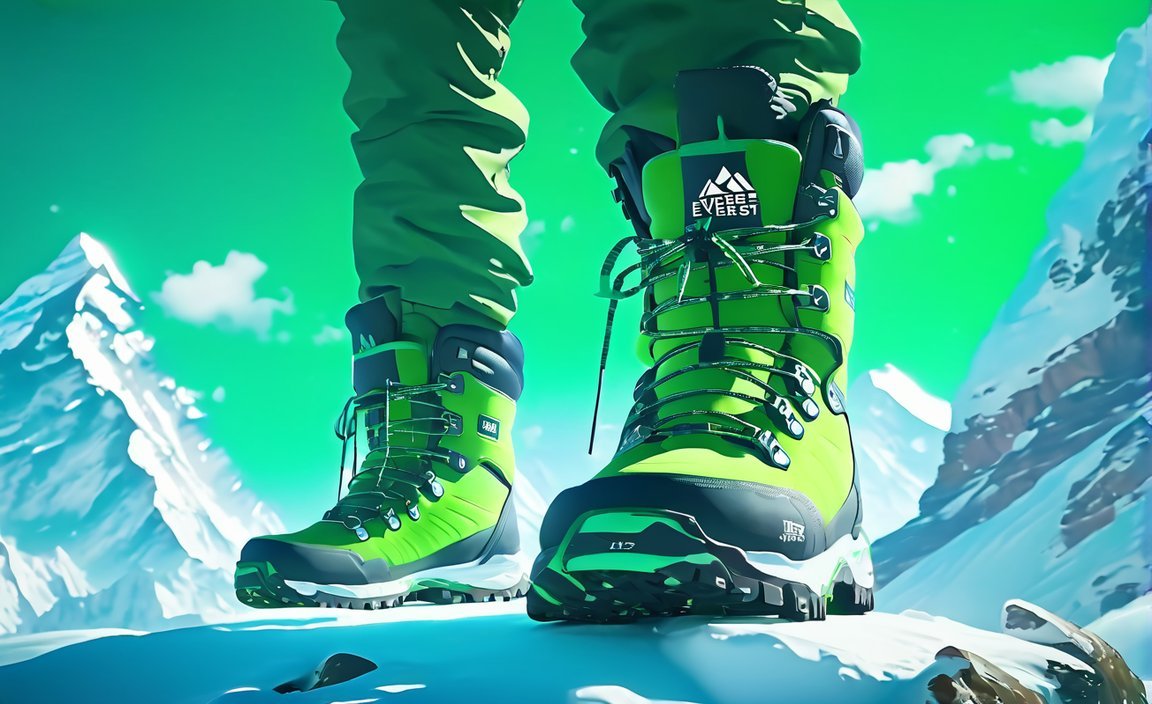Unveiling the Tale of Mount Everest’s Iconic Green Boots: Eternal Remembrance takes us on an extraordinary journey to the dark and treacherous world of the world’s highest peak. With every step, a lingering mystery haunts the climbers who dare to conquer Mount Everest – a haunting tale that centers around a pair of iconic green boots, forever frozen in time. This gripping account unravels the enigmatic story behind these legendary boots, symbolizing both triumph and tragedy on Everest’s perilous slopes.

Key Takeaways:
- Mount Everest’s Green Boots is the unidentified body of a climber that has become a landmark on the main Northeast ridge route.
- British filmmaker and climber Matt Dickinson captured the first recorded footage of Green Boots in May 1996, in a documentary called “Summit Fever.”
- Green Boots gained notoriety for its association with the death of climber David Sharp.
- The identity of Green Boots remains officially unknown, but speculations suggest it could be Tsewang Paljor or Dorje Morup, both members of an Indian expedition team that tragically lost their lives in 1996.
- Controversy surrounds the circumstances of the climbers’ deaths and the actions of other mountaineers who encountered them.
- The rescue efforts and conflicting accounts deepen the mystery of Green Boots and the events of 1996 on Mount Everest.
- Despite the unknown identity, Green Boots continues to hold a haunting presence and captivate mountaineering enthusiasts.
Mount Everest Green Boots
Mount Everest, the tallest peak in the world, holds many treacherous tales and mysteries. One such enigma is the story of “Green Boots,” the unidentified body of a climber that has become a landmark on the main Northeast ridge route of the mountain. Let’s delve into the history, possible identities, and controversies surrounding Green Boots.
History of Green Boots
The first recorded footage of Green Boots was captured in May 1996 by British filmmaker and climber Matt Dickinson. This film footage was included in the Brian Blessed documentary called “Summit Fever.” The unidentified climber, referred to as being from Nepal, caught the attention of climbers and became known as Green Boots due to the green Koflach boots he was wearing. Over time, Green Boots became a significant landmark on the north route of Mount Everest, gaining notoriety for its association with the death of David Sharp.
In 2014, members of a Chinese expedition moved Green Boots to a less conspicuous location, adding another chapter to the story of this mysterious mountaineer.
Possible Identities of Green Boots
The identity of Green Boots remains officially unknown, but there are speculations about his origin. Many believe Green Boots to be Tsewang Paljor, an Indian climber who was part of an expedition in 1996. Tsewang Paljor and two others attempted to summit Mount Everest but tragically lost their lives. It is also possible that Green Boots is the body of Dorje Morup, another member of the Indian expedition team. The disaster of 1996 claimed the lives of eight climbers overall, including five climbers from the Adventure Consultants and Mountain Madness expeditions on the southeast route.
Controversy and Rescue Efforts
Controversy surrounds the circumstances of the Indian climbers’ deaths and the actions of other mountaineers who encountered them. A team of Japanese climbers from Fukuoka reported seeing an unidentifiable object above the Second Step and encountered one person on a fixed rope during their descent. Ultimately, the Japanese climbers continued their descent due to limited oxygen supply and bad weather conditions. There were misunderstandings and disputes initially, but the Indian-Tibetan Border Police later accepted the Japanese team’s claim that they did not abandon or refuse to help the Indian climbers.
The rescue efforts and conflicting accounts further deepen the mystery of Green Boots and the tragic events of 1996 on Mount Everest.
The story of Green Boots, the unidentified climber on Mount Everest, holds a haunting presence on the main Northeast ridge route. The true identity of Green Boots may never be officially confirmed, but his significance as a landmark and the events surrounding his death will continue to intrigue those who dare to conquer the mighty Everest.
Sources:
Have you ever wondered if Green Boots is still on Everest? Find out the latest updates on this infamous landmark in our article Is green boots still on Everest.
Discover the highest elevation in Ohio and marvel at its scenic beauty. Read more about it here: Highest elevation in Ohio.
Ohio’s highest elevation offers breathtaking views that will leave you in awe. Explore this natural wonder by clicking on Ohio highest elevation.
Curious about the altitude of Kansas? Uncover interesting facts and figures about this state’s elevation by clicking here: Altitude of Kansas.
Michigan is known for many things, but did you know about its unique geographical features? Click here to find out why Michigan is famous: Michigan known for.
Embark on a journey to Nebraska’s high point and witness its breathtaking natural beauty. Discover more by clicking on Nebraska high point.
Experience the thrill of reaching the highest point of Arkansas and enjoy panoramic views from its summit. Learn more about it here: Highest point of Arkansas.
Controversies surrounding the green boots
Key Takeaways:
– The unidentified body of a climber known as “Green Boots” has become a landmark on the main Northeast ridge route of Mount Everest.
– Green Boots was first captured on film in 1996 and gained notoriety for its association with the death of David Sharp.
– In 2014, Green Boots was moved to a less conspicuous location by a Chinese expedition.
– The true identity of Green Boots is officially unknown but is believed to be Tsewang Paljor or Dorje Morup, members of an Indian expedition team in 1996.
– Controversy surrounds the circumstances of the Indian climbers’ deaths and the actions of other mountaineers who encountered them.
– Conflicting accounts and rescue efforts deepen the mystery of Green Boots and the tragic events of 1996 on Mount Everest.
Mount Everest’s treacherous slopes hold countless tales of triumph and tragedy, but one story has captivated the mountaineering community and sparked controversy for years – the legend of the “green boots.” This enigmatic symbol rests eternally on Everest’s perilous route, shrouded in mystery and controversy.
The green boots are the preserved body of an unidentified climber on Mount Everest’s main Northeast ridge route. This unforgettable landmark earned its name from the green boots worn by the fallen climber. The first recorded footage of the green boots was captured in May 1996 by British filmmaker and climber Matt Dickinson for the documentary “Summit Fever,” narrated by Brian Blessed. The haunting image of the green boots cemented their place in Everest’s history.
Controversy surrounding the green boots emerged from their association with the death of David Sharp, a British climber who perished on Everest in 2006. Many questioned whether mountaineers who encountered the dying Sharp failed to offer assistance. As allegations circulated, conflicting accounts further deepened the mystery of the green boots and the events surrounding the ill-fated expedition.
In 2014, the green boots were silently moved to a less conspicuous location by members of a Chinese expedition. Despite this relocation, the true identity of the fallen climber remains officially unknown. It is widely believed that the body could be that of Tsewang Paljor, an Indian climber who tragically lost his life on Everest in 1996. However, there is also a possibility that the green boots belong to Dorje Morup, another member of the Indian expedition party.
The Indian climbers – Tsewang Paljor, Lance Naik Dorje Morup, and Head Constable Tsewang Samanla – radioed their expedition leader from the summit on May 10, 1996, before vanishing into the unforgiving landscape. When reports suggested that a Japanese team may have encountered the missing Indian climbers but failed to assist them, controversy erupted. The Japanese team initially denied these claims, but they were later acknowledged by the Indian-Tibetan Border Police.
A 1997 article published in the Himalayan Journal proposed the possibility that the green boots could actually be the body of Lance Naik Dorje Morup. It mentioned the sighting of two climbers descending with the aid of head-torches, potentially indicating that Dorje Morup may have become the legendary figure of the green boots.
The controversy surrounding the green boots and the tragic events of 1996 on Mount Everest continue to intrigue and unsettle the mountaineering community. The search for answers and the desire for closure persist, perpetuating the legend that eternally lingers on Everest’s treacherous slopes.
SOURCES:
– Green Boots – Wikipedia
– Footage of Green Boots on YouTube
Efforts for the Removal of the Green Boots
Key Takeaways:
- Various efforts have been made to remove the iconic symbol of the green boots from Mount Everest.
- While some argue for the preservation of the boots as a historical marker, others believe their removal is necessary for both ethical and safety reasons.
- The Indian government has shown interest in recovering the remains of the climbers, but logistical challenges have hindered their efforts.
- The identification and repatriation of the bodies could bring closure to the families and honor the climbers’ memory.
Mount Everest is not only a towering peak that captivates the human spirit; it is also a graveyard that holds the frozen remnants of countless mountaineers who have dared to conquer its treacherous slopes. Among these solemn echoes of past expeditions lies the mysterious and iconic figure known as Green Boots. Over the years, numerous efforts have been made to remove Green Boots from its resting place, sparking a debate about the ethics and practicalities of such an endeavor.
Preservation versus Removal
The question of whether the green boots should be preserved or removed has been a subject of great controversy among the mountaineering community. On one hand, preserving the boots serves as a historical marker, reminding climbers of the unforgiving nature of Everest and honoring the endurance and bravery of those who have lost their lives. On the other hand, there are those who argue for the removal of the boots, citing ethical concerns and the need to create a safer environment on the mountain.
Ethical and Safety Considerations
The presence of Green Boots has raised ethical dilemmas regarding the treatment of human remains and the sanctity of the mountain. Some argue that leaving the climber’s body undisturbed respects their final resting place and the sacrifices they made. Others, however, believe that the removal of Green Boots is necessary for moral reasons, as it prevents further desecration of the site and ensures that climbers are not subjected to the distressing sight of a fallen adventurer.
Moreover, removing Green Boots could also contribute to the safety of climbers. In the treacherous terrain of Everest, avoiding potential hazards is crucial. The sight of Green Boots serves as a grim reminder of the dangers that lurk on the mountain. Removing the boots could reduce the risk of accidents caused by climbers becoming fixated on the landmark instead of focusing on their own safety.
Efforts to Remove Green Boots
Despite the ongoing debate, efforts have been made to remove Green Boots from its resting place. One notable attempt was made by the Chinese expedition in 2014, where the boots were moved to a less conspicuous location on the mountain. This action aimed to decrease the prevalence of Green Boots as a notable landmark while still respecting the climber’s memory.
Challenges and Future Outlook
However, complete removal of Green Boots from Mount Everest has proven to be a complex and challenging task. The harsh and unpredictable conditions, including extreme weather and treacherous terrain, pose significant logistical hurdles. Additionally, ethical and cultural considerations come into play, as different nations and climbing communities have varying perspectives on how to handle the remains of fallen climbers.
The identification of the climbers associated with Green Boots and the repatriation of their remains is an ongoing endeavor. The Indian government has expressed interest in bringing closure to the families of the climbers by recovering their bodies. However, the logistical complexities of such an operation have so far impeded their efforts.
In conclusion, the question of removing Green Boots from Mount Everest remains a topic of passionate debate within the mountaineering community. While some argue for preservation as a historical marker, others advocate for removal, citing ethical and safety concerns. As discussions continue, finding a balance between honoring the memory of fallen climbers and creating a safer climbing environment will remain the focus of future efforts.
URL Sources:
The Enduring Legacy of the Green Boots
On the treacherous slopes of Mount Everest, amidst the chilling beauty of the Himalayas, lies a haunting reminder of the fragility of life and the risks faced by mountaineers—the enigmatic ‘green boots.’ These neon green hiking boots belong to the unidentified body of a climber known as Green Boots, whose presence has become an enduring symbol on the main Northeast ridge route of Everest. This captivating tale of triumph and tragedy captures the essence of mountaineering and holds a profound legacy that continues to captivate climbers and enthusiasts alike.
The story of Green Boots begins in 1996 when a blizzard engulfed the mountaineers on Everest. Among the unfortunate victims was Tsewang Paljor, an Indian climber who, along with his team, embarked on a perilous journey to conquer the world’s tallest peak. As the blizzard raged, three team members chose to turn back, while Tsewang Paljor and two others decided to push forward. They made a final radio call from the summit before beginning their descent, but tragically, none of them returned to the high camp.
It is believed that Green Boots rests eternally within a limestone cave on the Northeast ridge route, earning the name from his distinctive neon green boots. Over the years, climbers have come to view this somber waypoint as they ascend towards the summit, paying their respects to the fallen climber. The poignant presence of Green Boots serves as a stark reminder of the risks and sacrifices that come with mountaineering.
In 2014, a Chinese expedition moved Green Boots to a less conspicuous location, but the legacy and intrigue surrounding this fallen climber remain unaltered. Mount Everest’s Green Boots continues to invoke a sense of wonder, curiosity, and reflection, making it an indispensable part of the mountain’s captivating history.
Key Takeaways:
- Green Boots is the unidentified body of a climber on Mount Everest, believed to be Tsewang Paljor, who died during a blizzard in 1996.
- The neon green hiking boots worn by Green Boots have become a landmark on the main Northeast ridge route of Mount Everest.
- Green Boots serves as a somber waypoint for climbers on their ascent, a reminder of the risks faced in mountaineering.
- The presence of Green Boots on Everest represents the enduring legacy of the climbers who have lost their lives on the mountain.
- Despite being moved to a different location in 2014, Green Boots continues to hold an enigmatic allure, drawing climbers and adventurers from around the world.
Sources:
– Everest Kalapathar Trek – Green Boots on Mount Everest
– All That’s Interesting – Green Boots: The Story Of Tsewang Paljor, Everest’s Most Famous Corpse

FAQ
Q1: Who is Green Boots on Mount Everest?
A1: Green Boots is the name given to the unidentified body of a climber that has become a landmark on the main Northeast ridge route of Mount Everest. It is believed to be Tsewang Paljor, an Indian climber who died on Everest in 1996.
Q2: How did Green Boots get its name?
A2: “Green Boots” got its name from the neon green hiking boots that the corpse wore. It has become a significant landmark on the north route of Mount Everest.
Q3: What is the history behind Green Boots?
A3: The first recorded footage of Green Boots was captured in May 1996 by British filmmaker and climber Matt Dickinson. The unidentified climber, referred to as being from Nepal, caught the attention of climbers and became known as Green Boots due to the green Koflach boots he was wearing. Over time, Green Boots became a significant landmark on the north route of Mount Everest, gaining notoriety for its association with the death of David Sharp.
Q4: Is Green Boots the body of Tsewang Paljor?
A4: It is commonly believed that Green Boots is the body of Tsewang Paljor, an Indian climber who was part of an expedition in 1996. Tsewang Paljor and two others attempted to summit Mount Everest but tragically lost their lives. However, it is also possible that Green Boots is the body of Dorje Morup, another member of the Indian expedition team.
Q5: What controversy surrounds Green Boots?
A5: Controversy surrounds the circumstances of the Indian climbers’ deaths and the actions of other mountaineers who encountered them. There were misunderstandings and disputes initially, but the Indian-Tibetan Border Police later accepted the claim of a team of Japanese climbers that they did not abandon or refuse to help the Indian climbers. The rescue efforts and conflicting accounts further deepen the mystery of Green Boots and the tragic events of 1996 on Mount Everest.















